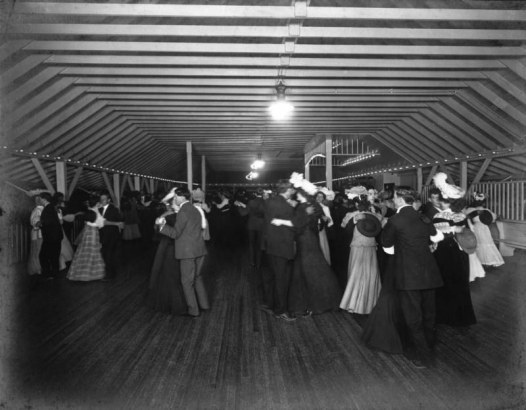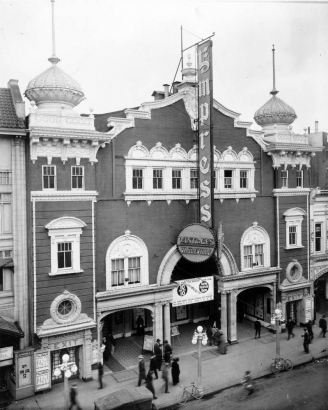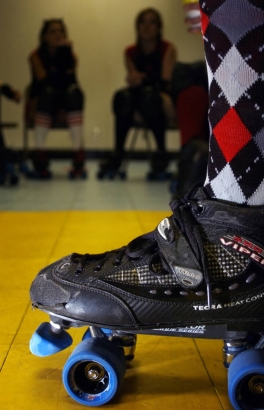While visiting Lincoln, Nebraska, in September I had the opportunity to visit the National Museum of Roller Skating. Contained in the museum's collection is memorabilia about the history of roller skating and the various sports and activities related to roller skating. I have a particular interest in roller derby as I have friends who compete and Denver has a strong community of roller derby enthusiasts. I decided to research the history of roller derby and was surprised to find that the creation of derby has strong ties to Denver.
The creation of roller derby is credited to Leo Seltzer, who founded the first roller derby league in Chicago in 1935. Seltzer began his career as the owner of a chain of movie theaters in Oregon. During the Great Depression, movie houses were losing business, which many thought was due to the rising popularity of endurance competitions. Pole sitting, endurance races, dance marathons and roller skating challenges were some of the activities that people were paying for as entertainment.
Due to the lack of business in his movie theaters Leo Seltzer began promoting dance marathons with his first being held the Empress Theater in Denver in 1931. He spent a few years promoting events in Denver before he moved to Chicago. History has proven that these endurance events weren't as lighthearted as they may seem. Many times the contestants entered because they were desperate to make a wage any way they could and often the marathons included free food for participants. Many of the spectators were more well-to-do than the competitors and attended the events to witness the poor putting themselves through great struggles to stay in the competition. Contestants were sometimes seriously injured and, in some extreme cases, died from overexertion.
When the popularity of endurance competitions was dying down, mostly due to the complaints of the mistreatment of contestants, Mr. Seltzer started brainstorming new ideas for activities to promote. Drawing on a restaurant tablecloth in Chicago's Ricketts restaurant in 1935 he came up with the idea of a roller marathon.
The first Transcontinental Roller Derby competition was held on August 13, 1935, at the Chicago Coliseum, with 20,000 spectators in attendance. Much like the endurance competitions, the contest lasted several days with contestants sleeping between rounds on cots in the Coliseum. Also like the endurance competitions of the past, several people had to leave the competition due to injury or exhaustion.
In 1937, sportswriter Damon Runyon suggested Seltzer increase the level of physical contact between the skaters in order to provide more excitement to competition. Roller derby's popularity rose steadily with the addition of physical contact until World War II when many of the competitors dropped out of the league to enlist in the armed forces or work on providing aid to the war effort. Many of the remaining skaters joined derby teams that served as entertainment for troops.
In 1958 Leo Seltzer transferred league ownership to his son, Jerry Seltzer. By 1973, high overhead and other factors led Jerry Seltzer to elect to shut down Roller Derby.
Since the 1970s there have been many rises and falls to the popularity of roller derby leagues. Currently, the sport's popularity is on the rise with over 12,000 leagues worldwide and two in Denver alone.
If you are interested to learn more about endurance competitions in Denver, newspaper articles can be found by searching the Western History subject index. For folks who are joining a roller derby team, take a look at Down and Derby :The Insider's Guide to Roller Derby in the library today.




Comments
Leo Seltzer's events were
Leo Seltzer's events were walkathons, where the contestants walked rather than danced to exhaustion....In a recent book on Marathons he is credited with being the first event promoter to set up standards for the events to protect the participants. Also, today there are approximately 1850 amateur leagues worldwide (see derbylisting.com). The most complete book of history of the sport from 1935 to its end in 1973 is "Roller Derby to Rollerjam", available in most lilbraries and amazon.com.
Thank you for the comments
Thank you for the comments Jerry, I used newspaper articles from the time and the Roller Skate museum's website for most of my information. Some articles described walkathons and dance marathons as being the same and often events titled a walkathon was actually more like a dance marathon.
Thank you for the book suggestion, that is not one we currently have in our library.
The restaurant in Chicago was
The restaurant in Chicago was Ricketts. The game gained popularity because the teams incorporated men and womens squads.
Thanks Jerry, I fixed it. I
Thanks Jerry, I fixed it. I think my subconscious wanted it to be Johnny Rockets!
There's now a more recent
There's now a more recent history of roller derby available. I believe the author interviewed Jerry Seltzer for the book, which was adapted from the writer's doctoral dissertation. The title is "Roller Derby: The History of an American Sport," by Michella Marino, who has also been a participant in a local team. (I'm not affiliated with the book in any way, I'm just providing updated info.)
Add new comment